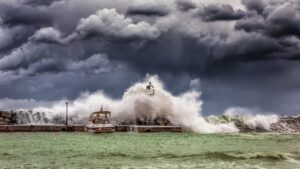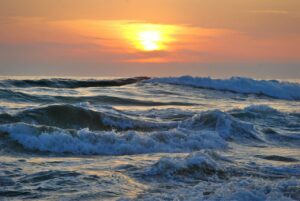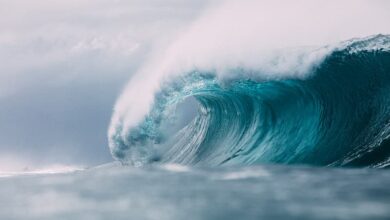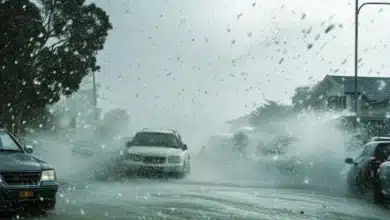What causes ocean currents?
Ocean water is dynamic because of its composition. Various kinds of ocean currents move over the surface of the oceans and seas in a predictable direction practically constantly. Currents in the ocean are responsible for both the horizontal and vertical components of the ocean’s circulation system.
Water in the ocean moves both horizontally and vertically, in the form of currents and waves, and vertically, in the form of tides.
A breeze may travel far faster than an ocean current. A typical ocean current travels between 3 and 9 kilometers per hour. In a race against the deep ocean, the shallow ocean current comes out on top.
It aids in the circulation of heat from the planet’s equatorial regions to its polar regions. Additionally, it is a major factor in the weather patterns that prevail around coasts. As a result, there is a connection between atmospheric circulation and ocean currents.
Types of Ocean Currents
Warm Ocean Currents
The term “warm ocean currents” refers to vast bodies of warm water moving across the ocean.
It is becoming warmer and farther away from the equator. When cold water gets salty and sinks, it creates a warm ocean current.
The procedure involves the reverse flow of warm, lighter water. The term “warm ocean current” is used to describe a current that originates in the tropics and moves northward.
Cold Ocean Currents
Large quantities of cold water that are moving toward the equator are known as cold ocean currents.
As a result, it descends from a higher to a lower height. They act as heat sinks, drawing energy from the tropics and releasing it as cooled air above them.
Cold air is pushed out to the equator when air from the subtropical high area blows over a body of cold ocean. A cold current describes a circulation in the ocean that runs across the icy waters of the Arctic or Antarctic.
Equatorial Currents
Equatorial currents are those that move across the ocean from the equatorial region. It has a generally westward flow pattern around the equator.
The Surface of Ocean Currents
Flowing from a warmer to a colder place, ocean currents move generally via the top section of the salt water or the surface. The term “surface ocean current” describes this kind of water flow.
Deep Ocean Currents
They are often found in more elevated areas. There, the colder water is carried by the river to the warmer waters below. This water makes up over 90% of the ocean.
Common Reasons behind the Ocean Current
Solar heating
Basically, it makes water puff up. About 8 centimeters more water may be found near the equator than in the mid-latitudes.
Water is slightly slanted and flows downhill as a result. Water with a higher temperature moves to the poles, whereas water with a lower temperature moves to the equator.
Wind
Ocean currents are caused by the wind because the wind blows the water on the surface of the ocean. Ocean water is redistributed according to density and temperature by surface currents, which are driven by the wind.
Gravity
Because of gravity, most things fall to the ground. In the ocean, the water tends to gather in the direction that the wind is blowing. The water flows down the ‘slope’ due to gravity, despite the pressure gradient.
Salt content
The salt content of water decreases as it advances towards the poles due to the freezing temperatures.
As a result, the water underneath becomes saltier and denser. Denser, colder, saltier water descends to the ocean bottom, where it is gradually replenished by warmer water from the top.
Temperature
Warm water has a tendency to remain near the ocean’s surface. Upwellings occur as colder, saltier water flows closer to the equator, where it warms and loses density, eventually rising to the ocean’s top.
Coriolis effect
Specifically, it alludes to the revolving of the Earth. The motion of any object in relation to Earth causes a reaction from the Earth. Since Earth is round, these effects are more pronounced at the poles and less noticeable closer to the equator.
Winds and currents in the Northern Hemisphere are deflected to the right by the Coriolis effect, whereas those in the Southern Hemisphere are deflected to the left.
Earthquakes in the Deep Sea
They may set off ocean currents, which carry large amounts of water onshore. Intense turbidity currents may be produced when earthquakes cause the downslope flow of water-saturated sediments.
Effects of Ocean Currents
Regulation of climate
One of the effects of ocean currents is the regulation of climate. Ocean currents are responsible for the movement of heat from the equator to the poles. As a result, it plays a role in the upkeep of the climate’s equilibrium. 
The ocean currents move things around like a conveyor belt. It moves water that is warmer from the equator toward the poles, and it moves water that is colder from the poles toward the tropics.
Even so, it contributes to the more even distribution of solar energy throughout the surface of the earth. If there weren’t any ocean currents, temperatures in different parts of the world would be much more severe.
For example, the equator would become incredibly hot, while the poles would become extremely cold.
Regulate marine life
The ocean currents ensure that the temperature of the water in the ocean is kept in a healthy equilibrium. This kind of water is responsible for the growth of tiny plants known as plankton, which are the primary source of nutrition for marine life.
As a consequence of this, the Grand Banks, New Falkland, the British Isles, Norway, and the coast of Japan all have an abundance of fish.
Raining
It is raining because the air moving over the warm current in the ocean is saturated with water vapor. Rain is produced when the water that has been evaporated rushes back over the land.
According to research that was published not too long ago, the Atlantic Ocean has an effect on the rainfall that occurs in the Western Hemisphere. The west coast of England receives rainfall because the warm currents of the Atlantic Ocean are directed there.
Snowfall
When air moves across a cold ocean current, it dries up. This results in snowfall. In order for there to be snowfall rather than rainfall as a result of this wind. Because of this factor, the Cold Labrador Currents cause an increase in the amount of snowfall that occurs around the coast of Labrador.
Snow-free port
Warm ocean currents cause the ice along the shore of the polar region to melt, creating a snow-free harbor. This makes navigating the site easier. The clearest illustration of this is seen in the coastal seaports of Norway, Canada, and other countries.
Fog and Storm
At the confluence of warm and cold ocean currents, fog and storms are common because of the varying warm and cool ocean currents and the rapid change in temperature that occurs in such a short area.
These factors contribute to the fact that New Falkland and Japan have fog for the vast majority of the year.
Conclusion
The motion of ocean water is caused by a number of different forces acting upon it. Wind, temperature, breaking waves, and tides are all examples of these, and occasionally subsurface factors such as earthquakes are included as well.






